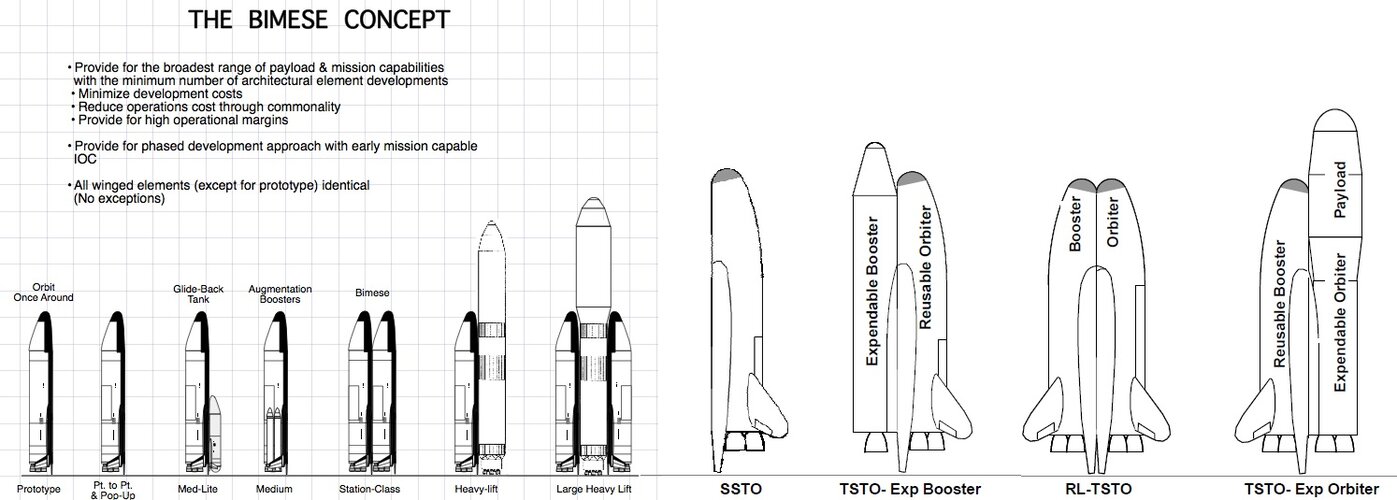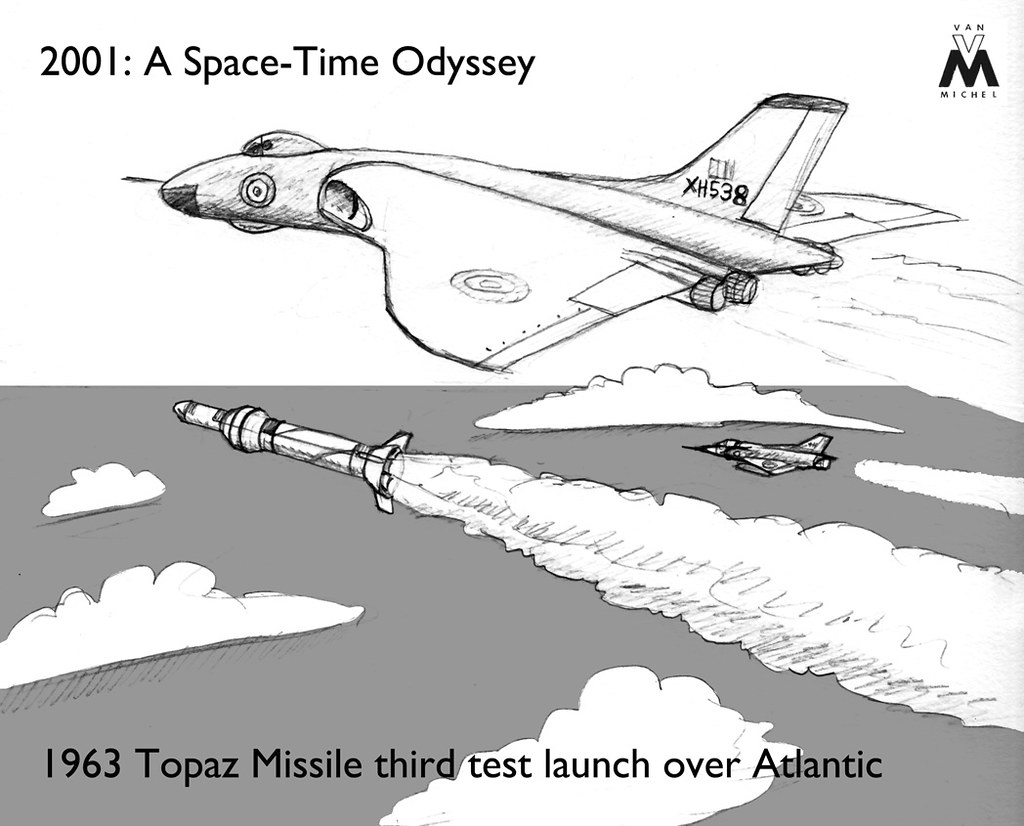martinbayer
ACCESS: Top Secret
- Joined
- 6 January 2009
- Messages
- 2,374
- Reaction score
- 2,100
I never liked the Hopper - I truly hate, detest, loathe, despise, abhor, dislike, and disdain all suborbital "launch" concepts. But I'm not bitter...
Crap, since your name was on one of the report, I assumed... oh well.I never liked the Hopper - I truly hate, detest, loathe, despise, abhor, dislike, and disdain all suborbital "launch" concepts. But I'm not bitter...
Can you provide me with a copy of that report? It's probably too late to do something about it, but at least I want to be aware of that stain. Since it was a FESTIP concept, I guess it's guilt by association...Crap, since your name was on one of the report, I assumed... oh well.I never liked the Hopper - I truly hate, detest, loathe, despise, abhor, dislike, and disdain all suborbital "launch" concepts. But I'm not bitter...
View: https://www.youtube.com/watch?v=sVi1go-hqh0
Is it really too much to ask to simply provide me with the file or at least title in question rather than send me on a puerile snipe hunt? I've never known you for playing coy when it comes to posting documents before. At least provide me with the exact title and number of the report, please, rather than vaguely referring to "à few results" (and I have no idea whatsoever why you put an accent grave on the "à")."festip""bayer, m." filetype: pdf on Google brings à few results.


(all the expletives deleted) YUCK!1973
Manned Orbiting Laboratory - strike two.
“There so many exciting combinations. We could launch a Big Gemini on top of a Titan IIIM just like NASA intends to do; except the cargo module would be stuffed with powerful spysat cameras from the NRO. But there are others alternatives that are equally fascinating. We could launch the same camera module without a crew capsule on top, saving 12 000 pounds of weight. The module could be fully automated, or it could be man-tended, that is a crewed capsule could visit it later and from time to time.
"But what crewed capsule ? Could be of course another military Big Gemini adding its cargo module to the first; but Titan IIIM are pretty expensive boosters. There are cheaper and much more flexible alternatives. Remember how we build five Gemini-B in the MOL days ? Well, NASA has seized them to flight test some Big Gemini stuff as early as 1974. In turn this gave us some interesting ideas.
"Gemini B is pretty light, barely 6000 pounds. So light that it is very close from the upper bound of our B-52, B-58 and B-70 air launching systems. Remember those use a mix of Minuteman and Agenas and, lets face it, it is not enough to push a Gemini B in orbit. Yet there is an alternative: Titan stages, liquid-fuel; they are very much like scaled up Agenas. But their LR87 and LR91 engine performance sucks, except if we mix Titan I and Titan II propellants: LOX from the former, hydrazine from the latter. That combo happens to have a tremendous specific impulse, even out of antiquated gas generator cycle rockets. Now, if you think a 50 000 pounds X-15A2 is the heaviest a NB-52 wing pylon can support, you are wrong: we could hang twice as much.
"And so we did the maths: an hybrid Titan stage 2, maxing out the NB-52 wing pylon... and surely enough, it could boost a Gemini-B in orbit, if barely. Can you believe that ? We could launch a Gemini capsule out of a B-52: runway-to-orbit. Once high there it would pick an Agena on its nose, NASA style for large in space manoeuvering. That Gemini-B could be used as our crew vehicle, since it has a hatch in the heatshield. It could be used for rescue of a stranded military Big Gemini; or it could fly alone, with a single crew and a camera sitting on the second seat.”
An empty Titan is under 20,000lbs?“So the plan would be to hang a stretched Titan second stage to a B-52 wing pylon, X-15 style. Takeoff, climb to 50 000 ft, Mach 0.85 and 30 degree angle of attack; before dropping the booster.
“My point exactly. And this can deliver 7000 pounds to orbit with a recovery kit, or 8000 pounds without it; quite respectable numbers. Philip Bono once noted a 250 000 pounds S-IVB could be retrieved from orbit at a cost of 6000 pounds of additional weight – what he called a recovery kit, but he included landing legs in the tally. Any Titan stage is far smaller than that, hence the kit is accordingly much lighter.
“A recovery kit ? “
“Yes. And off-the-shelf with that. Made of a Gemini heat shield (350 pounds), and Apollo parachutes - 140 pounds each, count three of them. Total mass of such recovery system would thus be less than 1000 pounds. Not that much of a weight penalty, when you think about it. So the stage would reenter nose-first, ablate its heat shield, pop its chutes...
“... and land downrange or at sea, which would make it tedious to recover.”
“No. There is an elegant and practical solution to that issue. We could snatch the stage midair with a big Sikorsky Skycrane, you know, that CH-54 beast they use in Vietnam to recover downed aircraft and drop huge BLU bombs to clear landing areas in the jungle. Hell, we could even fly that big chopper from a barge or an old carrier at sea - if that reassures precious FAA our booster won't crush a family home when hitting Earth solid ground. Whatever: end result would be a runway-to-orbit, two-stage, fully reusable system. Or: providing an orbital delivery capability to the Strategic Air Command B-52 fleet. And payload is nothing to sneeze at. In expendable mode we could almost orbit a MOL Gemini-B. Throw one Agena as the Gemini service module, adding one staging event and thus improving the system payload to orbit... and: there were are. Runway-to-orbit Gemini: from a B-52 wing pylon to a MOL space station. With only off-the-shelf building blocks: B-52, Titan, Agena, Gemini. Ain't that exciting ? “
(the math works, I swear its.)
And the CH-54 idea is very much a miniature.. this. https://www.thespacereview.com/article/3741/1
Far more realistic.
On a tangent:Hydrazine is the most evil fuel known to man!
Ah, I see you too have found Doctor Lowe's blog.
Doc Lowe inspired me to get my own (pdf) copy of "Ignition!"He sounds like John Clarke and his legendary book "Ignition !". When he discuss such gentle substances as boron fuels and fluorine, also beryllium. He has that almost legendary punchline (quoting from memory) "In case of a leak, the solution is - a good pair of running shoes".Also the Me-163 and its storable props that combusted everything: the plane, the pilot, and the mechanics.
Such nicely named substances as "red fuming acid" (sounds as if the thing is fuming in anger, turning red) and the aptly named FOOF - sounds like the noise of a flashpoint explosion.
FOOOOOF !!! - there goes the rocket, the pad, and any lifeform within 1 km radius.
I'm just seeing the login page for Publishdrive, were you intending to point to somewhere else?Meanwhile, I'm polishing that story, which has ballooned to a truly epic size... someday I may publish it as an e-book, via Amazon or (better) Publishdrive. But it needs to be trimmed and improved, and it is like Sysiphus and his goddamn rock...
https://account.publishdrive.com/login
Little side note:"But bomber scan be nuked on the ground and can't fly for weeks or months: unlike boomer subs."
"Oh, but the RAF has a solution to that. Borrowed from the French and theirMinerve program. Just scatter the Vulcan missile carriers across overseas territories: wherever there is a runway long enough in the former British empire, presently known as Commonwealth."
"I'm not sure Commonwealth nations accepts to become big targets for Soviet ICBMs..."
"You have apoint. The case of the French is different: they have full blown overseas territories all across the world: near Canada, in the Caribbean, near Brazil, in the Pacific and Indian ocean."
You have a point. Vulcan Polaris is probably a non starter.Is UK-Polaris dual-keyed or UK-keys-only in your timeline?
Because if dual-keyed, the US would have a say in just where those missiles can go, in terms of what access controls there are to the missiles proper.
In our timeline, it looks like the British effectively held most of the control of the Polaris missiles they had, since the warheads were of British design but packed into American-designed reentry bodies.You have a point. Vulcan Polaris is probably a non starter.
ICBM BASING OPTIONS
- A SUMMARY OF MAJOR STUDIES TO DEFINE A SURVIVABLE BASING CONCEPT...
CONCEPT DESCRIPTION/DISCUSSION AND EVALUATION
-Launch Under Attack
-Orbital Based
-Shallow Underwater Missile
-Hydra (heil... !!)
-Orca
-Ship — Inland
-Ship — Ocean
-Sea Sitter
-Wide Body Jet
-Short Takeoff and Landing (STOL)
-Vertical Takeoff and Landing (VTOL)
-Dirigible
-Midgetman
-Hard Rock Silo
-Hard Tunnel
-South Side Basing
-Sandy Silo
-Commercial Rail
-Dedicated Rail
-Off-Road Mobile
-Ground Effect Machine (GEM)
-Road Mobile (Minuteman)
-Road Mobile (New Missile)
-Covered Trench
-Hybrid Trench
-Dash to Sheiter
-Mobile Front End
-Pool
-Minuteman/MPS
-M-X/MPS
So, Able Archer went wrong in your timeline?Never, ever forget the sheer, absolute horror of nuclear warfare. And how 1983 brought the world way, way too close from the apocalypse.
...
Barefoot Gen
The day after
Threads
That year 1983, the horror of atomic warfare hit Japanese, British and American screens with absolute brutality. No horror was spared to the unfortunate spectators of these three masterpieces. People were burned alive, their eyes falling from their sockets as they screamed in horror, then vanished into dust - or just blackened skeletons. Survivors were zombified: burned from head to toes, their guts left hanging. Others were seemingly left untouched, only to die of radiation sickness: vomiting blood and guts.
...
What was even more disturbing was that Cold War reality seemingly tried to caught up with the on-screen horrors. On a gloomy fall, that year 1983 a chain of absurd events led to close-calls as frightening as 1962. Except this time the Soviets had caught up with the American nuclear stockpile - and then, almost doubled down.
The ultimate result of the Cold War insane nuclear arm race now had the world seating on a whopping 75 000 nukes; sixteen thousands megatons combined: first strike delivery.
A sixteen thousands million tons of TNT powderkeg: at the mercy of Reagan agressive rethoric and Andropov paranoid agony. It would only take a single misunderstanding to incinerate a few billion people and doom the unfortunate survivors to an horrible agony.
And the misunderstandings started in earnest.
